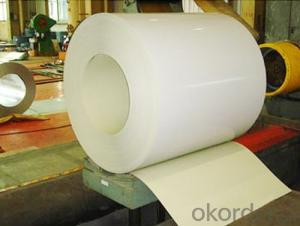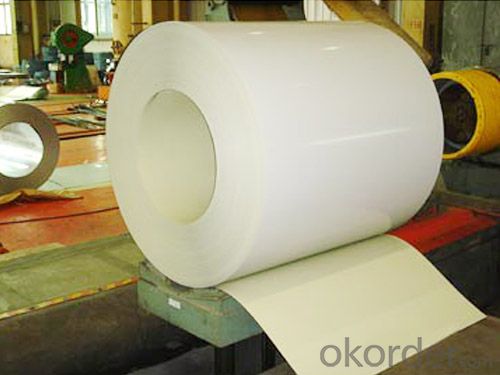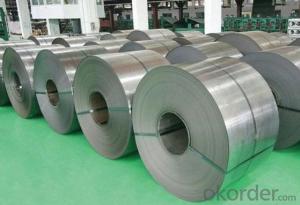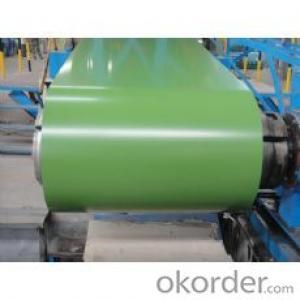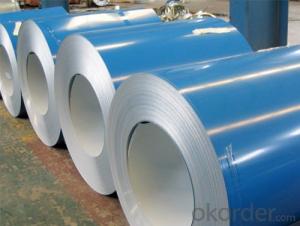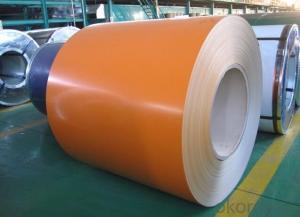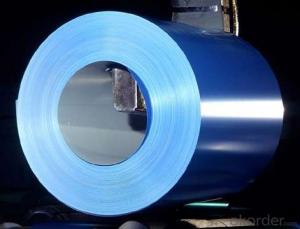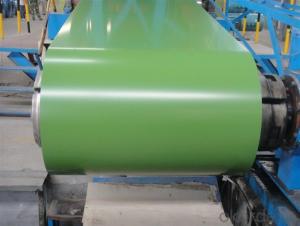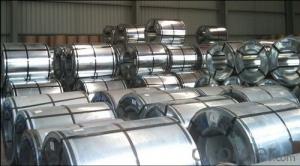PPGI Steel Sheet Coil with Nice Quality and Lowest Price Blue
- Loading Port:
- Shanghai
- Payment Terms:
- TT OR LC
- Min Order Qty:
- 111 m.t.
- Supply Capability:
- 11111 m.t./month
OKorder Service Pledge
OKorder Financial Service
You Might Also Like
1.Structure of Pre-painted Galvanized/Aluzinc Steel Coil Description
Pre-painted galvanized steel is good capable of decoration, molding, corrosion resistance.
It generally displays workability, durability and weather resistance.
2.Main Features of the Pre-painted Galvanized/Aluzinc Steel Coil
• good corrosion resistance
• perfect weather resistance
• Good formability
• Good visual effect
• High strength
3.Pre-painted Galvanized/Aluzinc Steel Coil Images
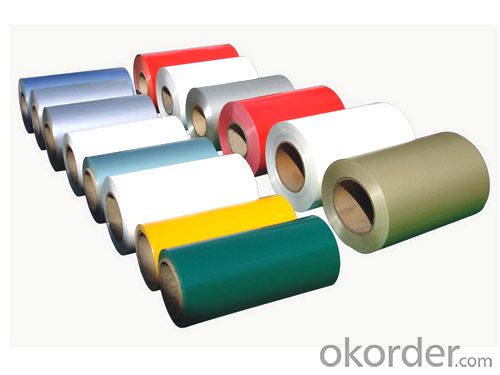
4.Pre-painted Galvanized/Aluzinc Steel Coil Specification
Paint thickness for top side : 5 micron primer + (10-20) microns modified polyester, any RAL color code.
Thickness : 0.14-1.20 mm
Paint thickness for back side: (5-10) microns Epoxy
Weight per coil: 4-6 tons, also can be upon customer's requirements
Quality standar: JIS G3312 CGCC & CGLCC
Hardness of P: Both soft and hard quality are available
Surface finish: with or without protect film
Width : 914mm, 1000mm, 1220mm and 1250mm, thickness 600-1250mm is available
Finish by coil or sheet: Both sheet and coil are available
8Zinc coating: 60-275G/M2, both sides
Max loading weight in one 20ft container : 25 tons generally
5. FAQ of Pre-painted Galvanized/Aluzinc Steel Coil
We have organized several common questions for our clients,may help you sincerely:
1. What is the minimum order quantity ?
Our MOQ is 50mt for each size. And we will consider to give more discount if you make big order like 1000 tons and more. Further more, the more appropriate payment term your offer the better price we can provide.
- Q: What is the role of steel coils in the oil and gas industry?
- Steel coils play a crucial role in the oil and gas industry. They are primarily used for the transportation and storage of oil and gas products. These coils are typically made of high-quality steel and are designed to withstand the harsh conditions encountered during the extraction, processing, and distribution of oil and gas. One of the main functions of steel coils in the oil and gas industry is to serve as transportation containers. Oil and gas are often transported over long distances, either through pipelines or by tankers. Steel coils are used to construct these pipelines and storage tanks, providing a robust and secure means of transporting these valuable resources. The durable nature of steel ensures that the pipelines and storage facilities can withstand the pressure and temperature fluctuations that occur during the transportation process. Steel coils are also an essential component in the production of drilling equipment. The drilling process involves extracting oil and gas from deep underground reservoirs. Steel coils are used to manufacture various components of drilling rigs, such as pipes, casings, and wellheads. These components must be able to withstand high pressures and temperatures encountered during drilling operations. Steel coils provide the necessary strength and durability to ensure the reliability and safety of drilling equipment. Furthermore, steel coils are used in the construction of offshore platforms. These platforms serve as bases for drilling operations in offshore oilfields. The harsh marine environment, including saltwater exposure and strong winds, requires materials that can withstand corrosion and provide structural integrity. Steel coils are used to fabricate the structural components of these offshore platforms, ensuring they can withstand the challenging offshore conditions. In summary, steel coils play a vital role in the oil and gas industry. They are used for transportation and storage of oil and gas products, construction of pipelines and storage tanks, manufacturing of drilling equipment, and fabrication of offshore platforms. The strength, durability, and resistance to harsh conditions make steel coils an indispensable material in the oil and gas industry.
- Q: How are steel coils used in various industries?
- Steel coils are used in various industries for their durability and versatility. They are commonly used in automotive, construction, and manufacturing industries for making structures, machinery, and appliances. Steel coils are also utilized in the energy sector for producing power generation equipment and in the transportation industry for making ships and railcars. Overall, steel coils play a significant role in providing strength and reliability in a wide range of industrial applications.
- Q: How are steel coils used in the manufacturing of mining equipment?
- Steel coils are used in the manufacturing of mining equipment to provide strength and durability to crucial components such as chassis, buckets, and structural frameworks. These coils are formed into various shapes and sizes, then welded or bolted together to create robust and reliable machinery capable of withstanding the harsh conditions and heavy loads encountered in mining operations.
- Q: PLS tell me all Foam Steel Characteristics and use?Thanks
- Foam steel [often steel foam] is used in applications that require light weight but high rigidity and strength. Watertight doors on modern ships are often made of foam steel. Pressure doors on aircraft are possible uses. As we keep striving for lighter weights in cars, foam steel might have some useful applications in bodies. There is a technical paper online that is in .pdf format that has a good discussion of the process and characteristics of foam steel.
- Q: Can steel coils be stored in a corrosive environment?
- No, steel coils should not be stored in a corrosive environment as it can cause damage and corrosion to the coils, reducing their quality and durability over time.
- Q: How are steel coils inspected for surface cleanliness using cleanliness tests?
- Steel coils are inspected for surface cleanliness using cleanliness tests through various methods such as visual inspections, magnetic particle inspections, and solvent extraction tests. Visual inspections involve visually examining the surface of the steel coils for any visible contaminants or defects. Magnetic particle inspections use magnetic particles that are applied to the surface of the coils, and if there are any defects or contaminants present, the particles will accumulate and make them visible. Solvent extraction tests involve using a solvent to extract any contaminants from the surface of the steel coils, and then analyzing the extracted solution to determine the level of cleanliness. These tests help ensure that the steel coils meet the required standards for surface cleanliness.
- Q: What is the difference between a steel strip and a coil? The steel strip is flat steel, and the steel coil is made of steel. Is that correct?
- A steel strip is also a coil, usually a narrow strip, also known as a steel strip. The volume is relatively wide. In addition, flat steel is usually hot-rolled out of long strip steel, fixed length 5 and 5.5,6 meters range, steel coil is Kaiping Chang 12501500, length 2.5 meters, 4 meters, 6 meters, ranging from steel plate
- Q: What are the common coil storage methods?
- The common coil storage methods include stacking coils vertically, using coil cradles or racks, and storing them horizontally on pallets or on the ground.
- Q: What are the different methods of coil recoiling for narrow strip widths?
- There are several different methods of coil recoiling for narrow strip widths. One method is known as slitting and recoiling, which involves cutting the wide coil into narrower strips and then rewinding them onto a smaller coil. This is typically done using a slitting machine, which can make precise cuts to create the desired strip widths. Another method is known as edge trimming and recoiling. In this process, the edges of the wide coil are trimmed to create narrower strips, and then the remaining material is rewound onto a smaller coil. This method is often used when the edges of the coil are damaged or uneven and need to be removed before recoiling. Additionally, there is a method called tension recoiling. In this process, the wide coil is passed through a series of tensioning devices that help to create the desired strip widths. The tensioning devices can apply controlled pressure to the edges of the coil, allowing for precise recoiling of narrow strips. Furthermore, some companies use laser cutting technology for coil recoiling. This method involves using a laser beam to cut the wide coil into narrow strips, followed by rewinding onto a smaller coil. Laser cutting offers high precision and accuracy, making it an ideal option for narrow strip widths. Overall, the different methods of coil recoiling for narrow strip widths include slitting and recoiling, edge trimming and recoiling, tension recoiling, and laser cutting. Each method has its own advantages and is chosen based on the specific requirements and capabilities of the manufacturing process.
- Q: What are the different types of steel coil handling devices?
- There are several types of steel coil handling devices, including coil lifters, coil grabs, coil tongs, coil hooks, and coil C-hooks. These devices are designed to safely and efficiently handle steel coils of various sizes and weights, allowing for easy transportation and storage in industrial settings.
Send your message to us
PPGI Steel Sheet Coil with Nice Quality and Lowest Price Blue
- Loading Port:
- Shanghai
- Payment Terms:
- TT OR LC
- Min Order Qty:
- 111 m.t.
- Supply Capability:
- 11111 m.t./month
OKorder Service Pledge
OKorder Financial Service
Similar products
Hot products
Hot Searches
Related keywords
